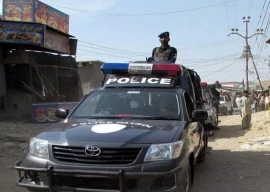
At the left of the Sukkur Barrage, water was flowing over the top of a gate. The river is supposed to flow under the giant steel gates that are cranked up to channel the flow. The engineers had allowed so much silt to build up that the height of the water had risen. When the visitor asked why the water was going over and not under the gate, the engineer lamely explained that they needed to get more water into the Rohri canal that branched off. “Meri neend haram ho gai,” said the man. He couldn’t sleep after he heard this and in the days that followed he tried to get in touch with the authorities to do something about this sorry state of affairs.
That man was none other than Illahi Bukhsh Soomro, better known as the influential former speaker of the National Assembly and member of one of Sindh’s historical families. But, for the purposes of this story, Illahi Bukhsh Soomro’s heritage holds no meaning. What matters instead is that he was once upon a time the chief engineer of the mighty Sukkur Barrage.
Sindh is green today because of the barrage, Illahi Bukhsh told Nisar Khuhro and Taj Haider, whose help he sought in waking up the irrigation officials. They were men of reasoning in the ruling Pakistan Peoples Party. He told them that given there had been a nine-year dry spell there was bound to be a wet spell in the offing and Sindh had to be prepared. They had to repair and maintain the barrage and canals in the eventuality that there would be a flood. Briefings were organised and in a last ditch effort a letter went to Sindh Chief Minister Qaim Ali Shah. Not much changed.
When the floods hit Sindh later this year there was much talk of whether the barrage would be able to withstand the pressure of the raging waters. History was hauled up to buttress arguments. There were superfloods in 1942, 1955 and 1976 when over 900,000 cusecs had coursed through the 60 something arches of the barrage. When the worst was over, officials congratulated themselves: the 1932 structure had proven itself.
But there is a more important question to ask now. What was the damage, if any, to the barrage? And did these floods serve as a wake-up call for the irrigation department after bunds broke and millions were devastated? On Nov 15, senior chief engineer and an expert on floods and sediment disaster management, Keigo San of the Japan International Consultant Agency (Jica), a sister concern of the World Bank, visited the barrage. He was briefed by chief engineer Mohammad Haroon Memon.
According to Memon, the bank is funding the rehabilitation and modernisation of the barrage and Keigo was sent as a consultant. Memon said that after a briefing Keigo said he was impressed with the design and structure of the barrage, which, after braving the super floods, appeared to be still intact. “JICA will let us know the ways and means to further strengthen and prolong the life of the barrage,” he said, adding that the expert also visited the Guddu barrage and expressed his satisfaction over its condition as well.
“Apparently we cannot see any damage to the structure,” added chief engineer Memon. According to them, the previous floods didn’t damage the structure with the exception of a problem developing in its right pocket in 2004. That year a pit developed near gate No. 1 and sensing the danger, major repairs were carried out. The entire flooring from gates No. 1 to 5 upstream and downstream were replaced and sheet piles were affixed to avoid any harm to the foundation. The work was done by the Frontier Works Organisation (FWO) at an estimated cost of one billion rupees.
The barrage itself needs constant upkeep as do its branching canals and their guide ways that channel water from the river into them, sort of like a service lane. Illahi Bukhsh Soomro pointed out that the problem with the river Indus is that because it is so long from top to bottom, it carries a lot of silt that it gathers along the way. Silt is heavy and tends to be in the centre of the water flow where there is maximum speed of the water. As a result, barrage and irrigation engineers have to carry out a sounding every day on the levels of silt. They need to close the canals every couple of weeks to de-silt the waterways or they get clogged up. This has not been the case. Similarly, no encroachments are allowed on the guide banks but today there are 10 acres of encroachments ranging from two mosques, houses on rent to even a restaurant.
Because of a change in the hydrological cycle, lesser and lesser water had been making its way to the barrage over the last few years, before this flooding. When the water flowing through the barrage is low in volume, sediment finds it easy to settle. The more silt that settles the more organic matter starts to grow in the area. Then when irrigation engineers try to remove the silt, the organic matter makes it difficult. As a result, you need to keep dredging the channel, which costs a lot.
In the right bank canals there was a lot of silt build-up. In a model study carried out in Pune, India in 1938-40 the British discovered that the designed amount of water supposed to pass through the barrage should have been 1.5 million cusecs but came down to 0.9 million cusecs.
But even then, it has stood strong when the floods brought 1.2 million cusecs. The question is now, whether the authorities will be smart enough to follow through on any JICA assessments and recommendations on damage, if any, and dredge the silt out and clean up the canals.
Published in The Express Tribune, November 27th, 2010.

1731329418-0/BeFunky-collage-(39)1731329418-0-165x106.webp)



1731737597-0/Untitled-design-(12)1731737597-0-270x192.webp)
1731746071-0/Untitled-design-(11)1731746071-0-270x192.webp)
1731749026-0/Copy-of-Untitled-(3)1731749026-0-270x192.webp)









COMMENTS
Comments are moderated and generally will be posted if they are on-topic and not abusive.
For more information, please see our Comments FAQ